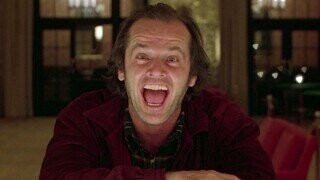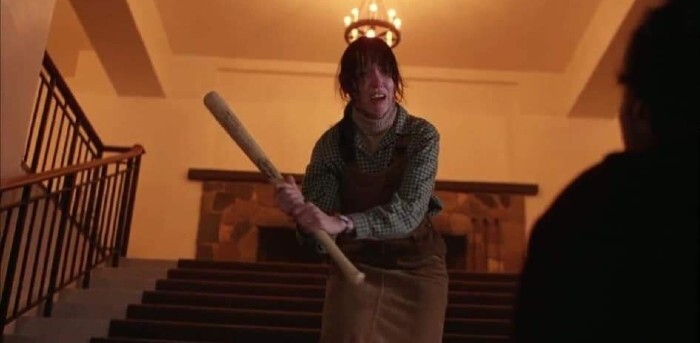15 Ax-Wielding Behind-the-Scenes Facts About 'The Shining'

(Warner Bros.)
On May 20, 1980, Stanley Kubrick and Stephen King’s weird ghost baby broke down the bathroom door to our hearts and nightmares. Though that baby is now squarely in middle age, The Shining still stands as a groundbreaking achievement in filmmaking, scaring the pants off people, and tormenting actors.
Robin Williams Nearly Starred

(Paramount Television)
Several actors were considered for the part ultimately played by Jack Nicholson, who King hated in the role because Jack Torrance was supposed to start out an affable everyman and Nicholson can’t help vibing chaos. One of those actors was Robin Williams, but after watching him on “Mork and Mindy,” Kubrick decided he was “too psychotic.”
Danny Lloyd Didn’t Know It Was a Horror Movie

(Warner Bros.)
To protect the child actor who played Danny Torrance from the grislier sights and sounds of the set, Kubrick told him it was just “a drama about a family that lived in a hotel,” banned him from the set during the filming of certain scenes, and gave Shelley Duvall a dummy to carry around instead. When filming was over, Lloyd spent the next five or six years believing he’d spent a year filming the 10-minute short they showed him.
The Overlook Hotel Doesn’t Exist

(Warner Bros.)
The Stanley Hotel in Colorado is known as the Shining hotel because it inspired King, but the hotel in the movie looks nothing like it. The exterior shots were filmed at Timberline Lodge in Oregon, but the interiors were all soundstages in England modeled after the Ahwahnee Hotel in Yosemite National Park, so a Shining tour would involve several flights.
The Layout Deliberately Changes
For someone whose perfectionism drove him to unprecedented levels of assholery, Kubrick left a lot of continuity errors in The Shining. Actors appear in different locations from shot to shot, and the layout of the hotel changes so much as to be impossible, sometimes within the same scene. It turns out these weren’t errors at all, though -- they were deliberately staged by Kubrick to unsettle the viewer, which would sound like retconning bullshit from absolutely anyone else.
It Could Have Had Several Different Endings

(Warner Bros.)
In King’s book and Kubrick’s initial screenplay, Dick Hallorann saves Wendy and Danny from Jack, who gets blown up with the hotel by the boiler he was too busy freaking out to maintain. Imagine the surprise of Scatman Crothers, the actor who played Hallorann, when he learned his character was actually going to be brutally murdered just because Kubrick believed horror movies must contain innocent deaths. Crothers was a fan of the book, so he was as disappointed as anyone with the change, but it could have been worse. Kubrick also considered Wendy killing Jack and then Hallorann becoming possessed.
Nicholson Eventually Stopped Trying to Learn His Lines
Those weren’t the only changes the script underwent. In fact, it was changed so often that Nicholson eventually gave up on trying to memorize it, often learning his lines only minutes before scenes were filmed.
Kubrick’s Perfectionism Broke Records

(Warner Bros.)
The Shining broke the Guiness World Record for most retakes of a single scene, with 127 takes of Shelley Duvall backing up the stairs with the baseball bat. Some people might take that as a hint, but Kubrick took it as a challenge, breaking the record again with 148 retakes of the scene with Danny and Hallorann discussing their psychic powers.
Kubrick Made Shelley Duvall’s Life Hell

(Warner Bros.)
Part of the reason Kubrick demanded so many takes of the staircase scene was that he was waging psychological warfare on Shelley Duvall to make sure she really was terrified all the time rather than just, you know, letting her act. He yelled at her, made her reshoot scenes until her hands bled, and generally made her so miserable that her hair started falling out from the stress.
The Typewriter Said Different Things in Different Countries

(Warner Bros.)
Since “All work and no play makes Jack a dull boy” doesn’t quite translate in other languages, what viewers saw on the typewriter depended on the language spoken in their country, and most of them are pretty anticlimactic. The sentence was “The morning has gold in its mouth” in Italian, “No matter how early you get up, you can’t make the sun rise any sooner” in Spanish, “What you have is worth much more than what you will have” in French, and “Never put off until tomorrow what can be done today” in German. If we saw our depressed husband typing that over and over, we’d be downright pleased.
Nicholson Was Too Good at Breaking Down Doors

(Warner Bros.)
Kubrick initially installed prop doors for Nicholson to chop through, not realizing it was the opposite of necessary. As a young man, Nicholson was trained as a firefighter in the Air National Guard, so he chopped through the fake doors so fast that he also chopped through all the tension in the scene.
Kubrick Didn’t Know Who Johnny Carson Was

“Heeeeere’s Johnny!” wasn’t in the script -- it was an ad-lib by Nicholson. You’d think Kubrick wouldn’t tolerate such insubordination, but despite having lived in England since the early ‘60s and therefore having no idea who Johnny Carson was or what the line meant, he left it in.
The Set Burned Down
As production of The Shining came to a close, a fire broke out, burning down much of the set as if the devil himself decided to drag the movie into hell (or, more likely, the 700,000 watts of light per window needed to make it look like a snowy day took their toll). Unfortunately, Nicholson’s firefighting skills were no use there. A famous photo shows Kubrick laughing amid the wreckage because he wasn’t immune to going insane, either.
Kubrick Ordered Any Extra Footage Destroyed
It was just as well, because Kubrick never allowed for any leftovers. He always destroyed any footage that wasn’t used in the final cuts of his films, including in this case scenes that actually screened in theaters before he decided to make another post-premier chop. He did it so no one could ever re-edit his movies, but feel free to speculate on what kind of demonic presence might have been glimpsed in the destroyed footage.
An Entire Score Was Lost
It’s hard to imagine The Shining without its screechy score, but that wasn’t its only one. Kubrick initially hired Wendy Carlos and Rachel Elkind to score the film and then decided at the last minute to scrap nearly the whole thing and start over. The only vestiges of their score that remains is the opening title, the scene where the Torrances drive up the mountain, and “several textures within the film were not much to hear by themselves,” according to Carlos. She did eventually release the score herself in 2005, but the pair coincidentally never worked with Kubrick again.
Stephen King Hated It

(Warner Bros. Television)
A guy who gets adapted as often as Stephen King learns to roll with it, but he particularly hated The Shining, describing it as “a beautiful car that has no engine in it.” That’s somewhat understandable: Kubrick not only admitted that he didn’t get the story at all, he reminded everyone every chance he got, telling crew members, “I never explain anything. I don’t understand it myself. It’s a ghost film!” King even produced his own miniseries in an attempt to get it right and learned a valuable lesson about staying in his lane.
Top image: Warner Bros.